Key takeaways:
- Development costs vary widely from $40K to $300K+ depending on features and scalability.
- Software types range from basic dashboards to advanced AI-powered enterprise suites.
- Factors like integration needs, security standards, and user roles heavily influence pricing.
- Smart strategies like MVP development, open-source tools, and cloud infra can optimize cost.
- Monetization models include SaaS plans, usage-based billing, white-label resale, and more.
Data is changing everything — especially in healthcare. If your business isn’t already using powerful analytics to help clients make smarter decisions, you’re missing out on a huge opportunity. Healthcare analytics software lets you turn complex data into clear insights that improve care, reduce costs, and create new revenue streams.
For leaders like you, building or offering a white-label analytics platform means you can meet growing demand without reinventing the wheel. But before jumping in, it’s important to understand the investment involved.
The cost to build a white-label healthcare analytics software can vary widely — typically anywhere from $40,000 up to $250,000 or more. This range depends largely on the complexity of the features you want, the level of customization, the integrations required, and the scale at which the platform needs to operate.
Getting a clear picture of these costs upfront is crucial. It not only helps you plan your budget effectively but also ensures you’re making informed decisions about which features to prioritize and where you might optimize expenses without sacrificing quality.
Let’s take a closer look at what influences these costs and how you can navigate the development process smoothly.
Global Healthcare Analytics Market Trends & Growth: Why Smart Businesses Are White-Labeling Their Way In
The healthcare analytics market is growing rapidly in 2024 and 2025, making it a prime time for businesses to invest in white-label healthcare analytics software development.
According to Grand View Research, the global healthcare analytics market is projected to grow from $43.1 billion in 2023 to $167.0 billion by 2030, representing a compound annual growth rate (CAGR) of 21.1% from 2024 to 2030. This explosive growth is fueled by the increasing adoption of data-driven decision-making across healthcare providers and payers.
McKinsey further reports that healthcare data is expected to expand at a CAGR of 36% through 2025, driven by the rising use of electronic health records (EHRs), wearable health devices, and telemedicine platforms. This massive increase in available data is creating strong demand for advanced healthcare analytics software solutions.
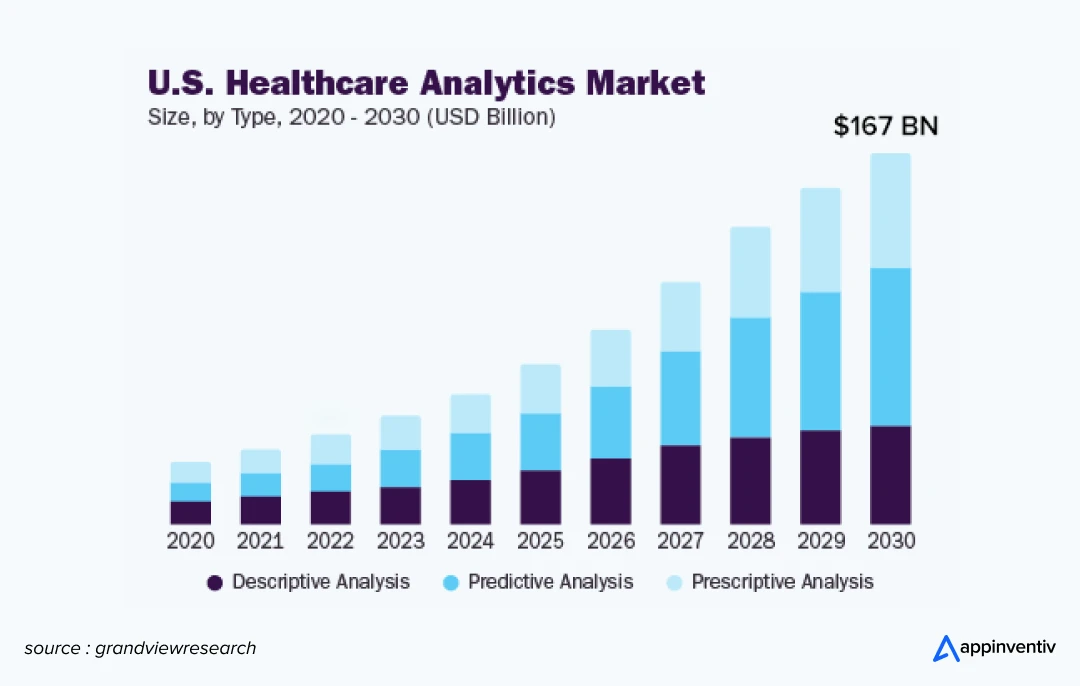
Given these market insights, now is an excellent opportunity for businesses to develop and offer white-label healthcare analytics software. The combination of soaring healthcare data volumes, accelerating technology adoption, and growing analytics budgets highlights the strategic importance of investing in scalable, customizable analytics platforms.
Investing in white-label healthcare analytics software development positions your business to capitalize on this momentum, meet evolving healthcare industry demands, and secure a competitive edge.
Now that we’ve explored why healthcare data analytics is booming, let’s dive into the cost to build a white-label healthcare analytics software — the key factors that influence pricing, development phases, and budgeting strategies.
How Much Does It Cost to Build a White-Label Healthcare Analytics Software?
As mentioned earlier, the white-label healthcare analytics software development cost typically ranges between $40,000 to $250,000 or more, depending on factors like feature complexity, technology stack, level of customization, integration requirements, and scalability needs. A simple analytics dashboard with limited functionality will be on the lower end of this range, while an enterprise-grade, AI-powered platform with multi-tenant capabilities will require a significantly higher investment.
To estimate your project cost, use this basic formula:
Development Time (in hours) × Hourly Rate = Total Healthcare Analytics Software Development Cost
This calculation helps you understand the total time and investment needed by multiplying the number of development hours by the hourly rate of your chosen development team.
It’s also important to know how the total development cost breaks down across various phases of healthcare analytics software creation for better budgeting and planning. Here’s a rough estimate:
| Phase |
Duration |
Estimated Cost Range |
| Research & Discovery |
3–5 weeks |
$8,000 – $20,000 |
| UI/UX Design |
4–7 weeks |
$12,000 – $35,000 |
| Backend & Frontend Development |
10–24 weeks |
$40,000 – $160,000+ |
| Testing & Quality Assurance |
3–5 weeks |
$8,000 – $30,000 |
| Deployment & Launch |
1–3 weeks |
$5,000 – $15,000 |
| Maintenance & Support (Ongoing) |
Monthly |
$1,500 – $12,000/month |
While these phase-wise estimates provide a strong starting point, the cost to build a white-label healthcare analytics software also varies significantly depending on the type of solution you’re building and the use cases you want to address.
Types of White-Label Healthcare Analytics Software and Their Cost Range
The type of healthcare analytics solutions you decide to develop plays a major role in shaping your project’s cost, scope, and timeline. Here’s a breakdown of common types of white-label healthcare analytics software, along with explanations to help you understand what each entails and their typical cost ranges:
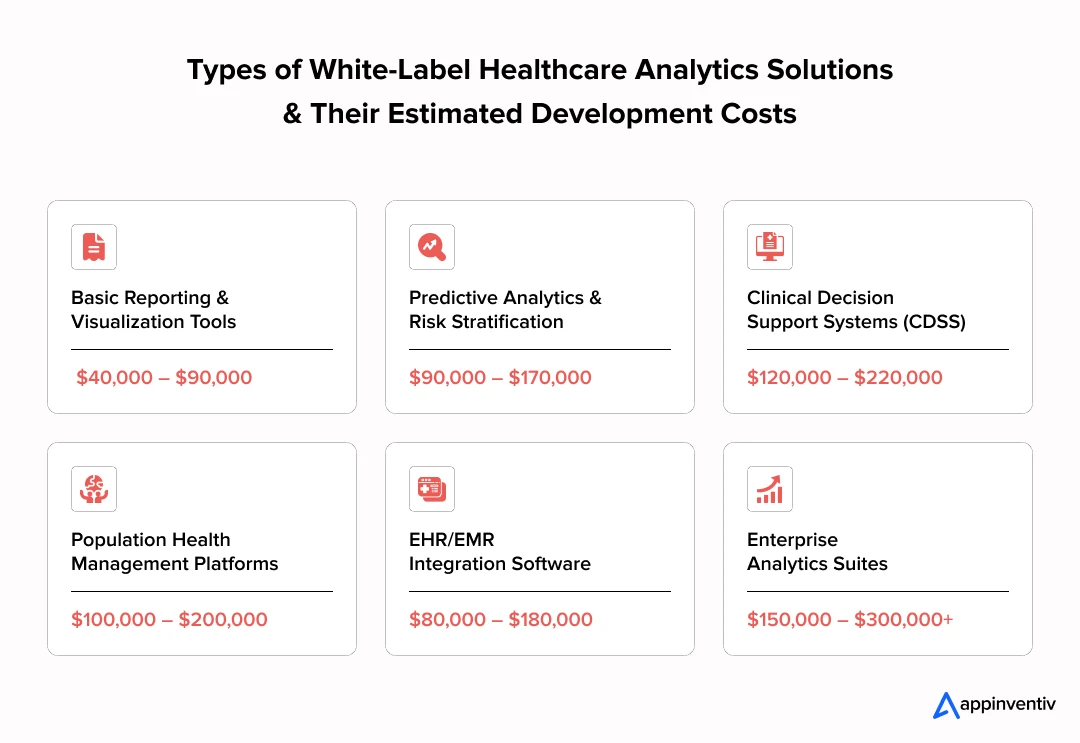
1. Basic Reporting and Visualization Software
These platforms primarily focus on collecting healthcare data and presenting it through straightforward dashboards and standard reports. They allow users to track key metrics like patient volume, resource utilization, or billing data but usually don’t offer advanced predictive or real-time insights.
Estimated Cost: $40,000 – $90,000
2. Predictive Analytics and Risk Stratification Platforms
These solutions go beyond simple reporting by incorporating AI and machine learning models to analyze historical and real-time data. They help forecast patient risks, predict outcomes, and identify high-risk populations, enabling providers to intervene earlier and improve care quality.
Estimated Cost: $90,000 – $170,000
3. Clinical Decision Support Systems (CDSS)
CDSS tools integrate directly into clinical workflows, providing real-time insights and recommendations to healthcare professionals as they make patient care decisions. These clinical analytics software can alert clinicians to potential issues such as medication conflicts, suggest treatment options, or flag abnormal lab results. This requires more complex integrations and strict compliance.
Estimated Cost: $120,000 – $220,000
4. Population Health Management Tools
These platforms are designed to collect and analyze health data across entire populations or care networks. They help healthcare organizations identify trends, monitor outcomes, and manage chronic diseases at scale. Population health tools often include care coordination features and support multi-provider data aggregation.
Estimated Cost: $100,000 – $200,000
5. Custom EHR/EMR Integration Solutions
Building seamless connections with existing Electronic Health Record (EHR) or Electronic Medical Record (EMR) systems is critical for many analytics platforms. Custom integration solutions involve developing tailored connectors or middleware to ensure smooth data exchange and interoperability with various healthcare software systems.
Estimated Cost: $80,000 – $180,000
6. Comprehensive Enterprise Analytics Suites
These are large-scale, multi-tenant platforms built to support multiple healthcare organizations or large networks under a single solution. They combine advanced features like AI-driven insights, compliance modules, user role management, and extensive reporting capabilities, making them the most complex and feature-rich options available.
Estimated Cost: $150,000 – $300,000+
After understanding the cost variations by software type, it’s important to explore the factors affecting the cost of white-label healthcare analytics software development and how you can optimize your investment without compromising on quality or functionality.
Factors Affecting the Cost of White-Label Healthcare Analytics Software
Several key factors affecting the cost of white-label healthcare analytics software development can significantly influence your overall investment. Understanding these elements helps you prioritize features and manage your budget effectively while building a scalable, compliant solution.
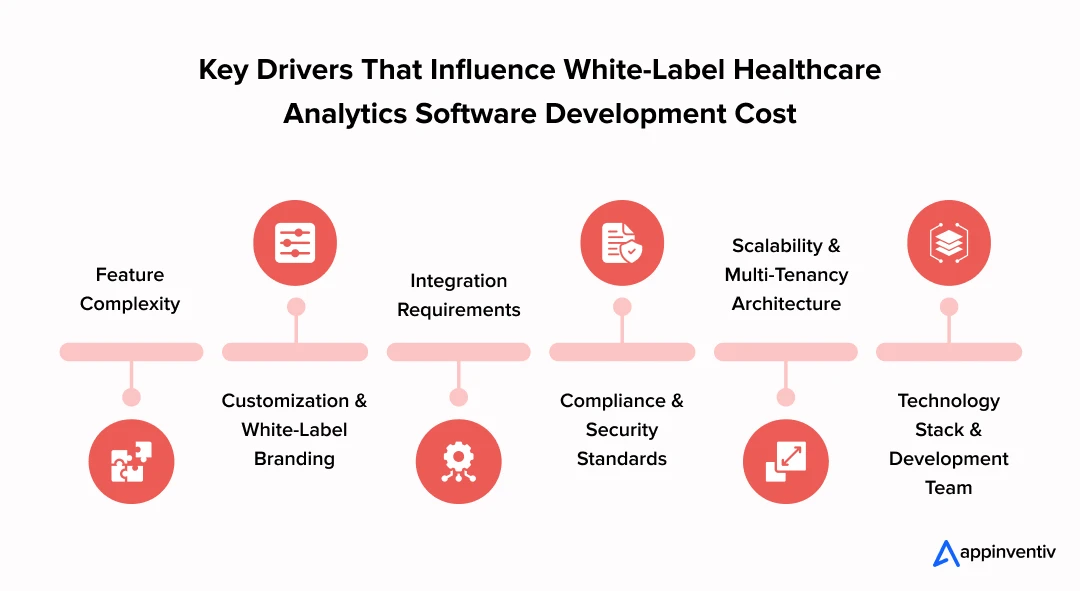
1. Feature Complexity
The features of a healthcare analytics software are the biggest cost drivers. Basic dashboards and reports are less expensive, but adding advanced capabilities like AI-powered predictive analytics, real-time clinical decision support, or natural language processing increases development time and cost to build a white-label healthcare analytics software.
| Complexity Level |
Estimated Development Time |
Estimated Cost Range |
| Basic |
3–4 months |
$40,000 – $70,000 |
| Moderate |
4–6 months |
$70,000 – $120,000 |
| Advanced |
6–9 months |
$120,000 – $180,000 |
| Enterprise |
9–12+ months |
$180,000 – $250,000+ |
2. Customization and White-Label Branding
Offering a truly white-label healthcare analytics software means deep customization — from user interfaces to workflows tailored for different healthcare clients. The more bespoke the solution, the higher the design and development effort. Thus, the overall cost for building analytics software for healthcare is ultimately affected.
3. Integration Requirements
Integrating with existing healthcare systems, such as EHRs, EMRs, lab information systems, or medical devices, requires custom connectors and middleware. These integrations are complex and add to the healthcare analytics software challenges, especially around data standardization and interoperability.
[Also Read: Achieving Interoperability in Healthcare IT – The Whys and Hows]
4. Compliance and Security
Meeting healthcare regulations like HIPAA, GDPR, and FDA guidelines demands rigorous security measures, data encryption, and audit trails. Ensuring your software complies with these standards adds significant engineering and testing efforts, impacting the white-label healthcare analytics software development cost.
5. Scalability and Multi-Tenancy
If your platform needs to serve multiple healthcare organizations with secure, isolated data environments (multi-tenancy), this increases architectural complexity and hosting costs. Designing for scalability also requires investing in robust infrastructure and cloud services.
6. Technology Stack and Development Team
The choice of technology stack (cloud providers, AI frameworks, frontend/backend technologies) affects development speed and cost. Additionally, hiring experienced developers familiar with healthcare data analytics software and industry standards may command higher rates but reduce risks and improve quality.
Hidden Factors Affecting the Cost of White-Label Healthcare Analytics Software
Beyond the obvious drivers, several hidden factors can significantly impact your white-label healthcare analytics software development cost. Being aware of these helps you avoid surprises and better manage your project budget.
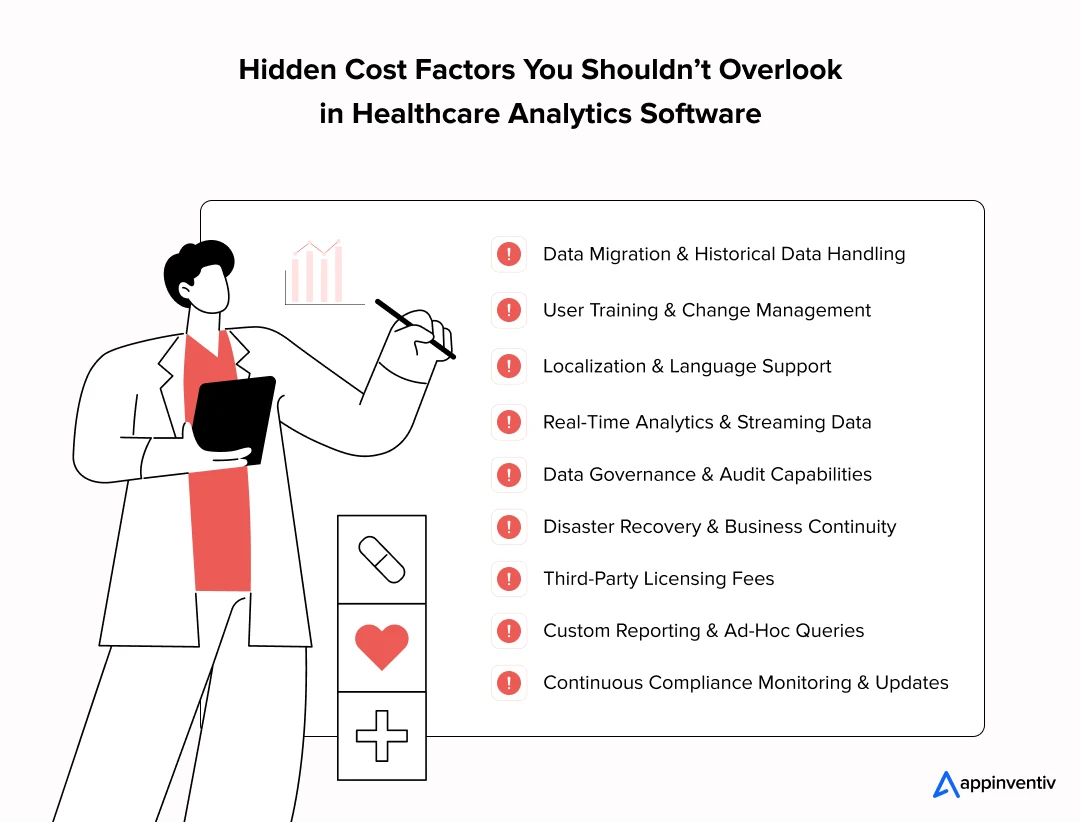
1. Data Migration and Historical Data Handling
Transferring and cleansing legacy healthcare data from multiple sources into the new analytics platform requires additional time and effort. Ensuring accuracy and consistency during migration can add complexity and cost.
2. User Training and Change Management
Developing training materials, onboarding programs, and user support tools to help healthcare professionals adapt to the new software involves resource allocation that impacts overall cost.
3. Localization and Language Support
Supporting multiple languages and regional healthcare regulations involves extra development for UI translation, date/time formats, currency, and compliance nuances.
4. Real-Time Analytics and Streaming Data Support
Processing and analyzing streaming data from devices and sensors in real-time demands advanced architecture and technologies, increasing both development and infrastructure costs.
5. Data Governance and Audit Capabilities
Implementing comprehensive data governance frameworks, including audit logs, data lineage, and user activity tracking, is essential for regulatory compliance but requires extra engineering effort.
6. Disaster Recovery and Business Continuity Planning
Building robust backup, failover, and disaster recovery mechanisms to ensure platform reliability and uptime adds to infrastructure complexity and cost.
7. Third-Party Licensing Fees
Using proprietary AI models, analytics engines, or specialized healthcare data platforms may involve recurring licensing fees that should be factored into your budget.
8. Custom Reporting and Ad-Hoc Query Support
Allowing users to create highly customized reports or execute complex, ad-hoc queries on large datasets requires more flexible backend design, increasing development time.
9. Continuous Compliance Monitoring and Updates
Healthcare regulations evolve frequently, so maintaining ongoing compliance through software updates and audits is a hidden cost that needs budgeting.
By carefully evaluating these factors, you can strike a balance between essential features and budget constraints — ensuring you build an effective, future-ready advanced healthcare analytics software platform.
Next, we’ll explore strategies to optimize your cost to build a white-label healthcare analytics software without compromising on quality.
Strategies to Optimize white-label Healthcare Analytics Software Development Cost
Building advanced healthcare analytics software can be a substantial investment, but with smart planning, you can optimize your spending while still delivering a robust, scalable product. Here are some proven strategies to reduce the white-label healthcare analytics software development cost without compromising on quality:
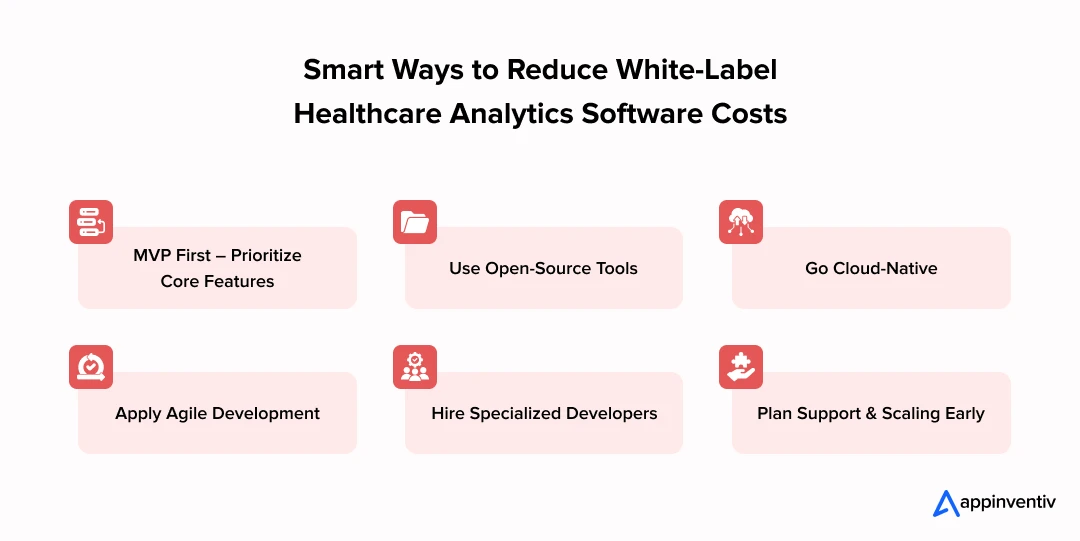 1. Prioritize Core Features with an MVP Approach
1. Prioritize Core Features with an MVP Approach
Focus initially on building a Minimum Viable Product (MVP) that includes only the essential features of a healthcare analytics software. Launching with core capabilities lets you test market fit, gather user feedback, and avoid over-investing in complex functionalities that may not be immediately necessary.
2. Leverage Open-Source and Existing Frameworks
Using established open-source tools and analytics frameworks can significantly cut development time and cost of data analytics solutions for healthcare businesses. Many trusted platforms provide foundational components that speed up development of healthcare data analytics software.
3. Choose Cloud-Based Infrastructure
Cloud platforms like AWS, Azure, or Google Cloud offer scalable, pay-as-you-go services that help manage infrastructure costs. They also provide compliance certifications that reduce your burden in meeting healthcare data security standards.
4. Implement Agile Development Practices
Agile methodologies enable iterative development with continuous feedback loops. This helps identify costly issues early, adapt to changing requirements, and deliver value faster — all contributing to optimized cost to build a white-label healthcare analytics software.
5. Outsource or Hire Specialized Developers
Consider hiring experienced developers for white-label healthcare analytics software development who understand regulatory requirements and industry challenges. Outsourcing to a reputable team can offer cost efficiency without sacrificing expertise.
6. Plan for Post-Launch Support and Scaling
Budgeting for maintenance, updates, and scaling upfront avoids unexpected expenses later. Well-planned support ensures your advanced healthcare analytics software remains reliable, secure, and competitive as user needs evolve.
By applying these strategies, you can build a powerful and compliant white-label healthcare analytics software platform that meets market demands while optimizing your investment.
Essential Features of white-label Healthcare Analytics Software
To build a truly effective healthcare analytics solution, your white-label platform should include a comprehensive set of features. These features of a healthcare analytics software ensure it meets the complex needs of healthcare organizations while maintaining security, usability, and compliance.
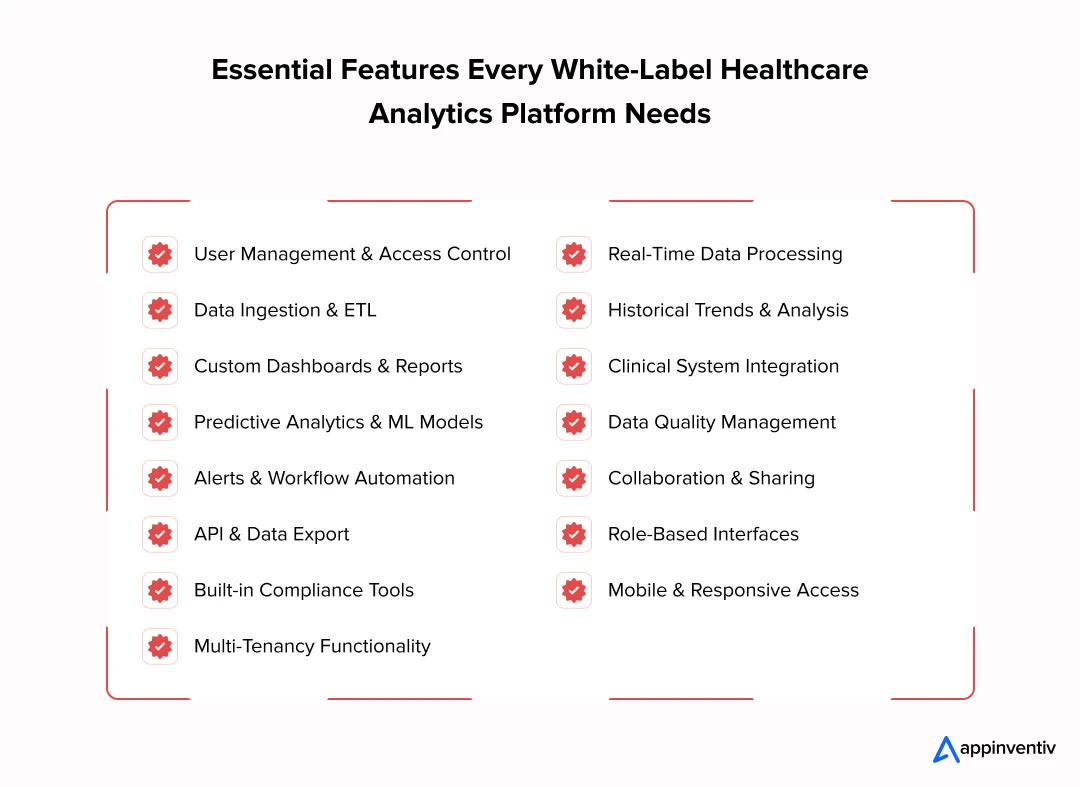
- User Management and Role-Based Access Control
Secure access with customizable roles ensuring each user sees only what they’re authorized to view, protecting sensitive patient data.
- Data Ingestion and ETL Pipelines
Efficiently gather, clean, and normalize data from diverse sources like EHRs, medical devices, labs, and patient-generated data, supporting multiple healthcare data standards (HL7, FHIR, DICOM).
- Customizable Dashboards and Reports
Intuitive and interactive dashboards with drag-and-drop features, enabling healthcare providers and administrators to create personalized views and reports based on their unique needs.
- Predictive Analytics and Machine Learning Models
Leverage AI-powered tools to forecast patient risks, identify disease outbreaks, predict readmissions, and optimize resource allocation.
- Alerts, Notifications, and Workflow Automation
Real-time alerts for critical health events, task reminders, and automated clinical workflows help improve patient safety and staff efficiency.
- API Access and Data Export
Secure APIs facilitate integration with third-party applications and systems, allowing seamless data sharing and interoperability.
- Compliance and Security Features
Built-in HIPAA, GDPR, and FDA compliance tools including data encryption (at rest and in transit), audit trails, multi-factor authentication, and secure data storage.
- Multi-Tenancy Support
Enable multiple healthcare organizations or departments to use the platform independently with strict data isolation and customizable branding for each tenant.
- Real-Time Data Processing
Support streaming data and real-time analytics for immediate insights and rapid clinical decision-making.
- Historical Data Analysis and Trend Monitoring
Tools to analyze long-term patient outcomes, operational performance, and epidemiological trends over time.
- Integration with Clinical and Operational Systems
Seamlessly connect with EHRs, Laboratory Information Systems (LIS), Radiology Information Systems (RIS), billing, and pharmacy systems.
- Data Quality and Validation Tools
Automated processes to detect and correct data inconsistencies or errors, ensuring reliability of analytics outputs.
- Collaboration and Sharing Tools
Allow users to share reports, dashboards, and insights securely across teams, departments, or external partners.
- Role-Specific Views and Interfaces
Tailored UI/UX for different users such as clinicians, administrators, analysts, and executives, enhancing usability and engagement.
- Mobile Access and Responsive Design
Ensure that users can access analytics and reports securely on mobile devices, enabling care on-the-go.
By including these core features, your healthcare data analytics software will be well-equipped to address the diverse challenges healthcare providers face, driving better outcomes and operational excellence.
Advanced Features to Elevate Your white-label Healthcare Analytics Software
Beyond the essentials, incorporating advanced capabilities transform your platform into a cutting-edge advanced healthcare analytics software solution — one that delivers deeper insights, greater automation, and stronger competitive differentiation. Businesses must understand that these advanced feature integrations can ultimately increase your overall cost to build a white-label healthcare analytics software.
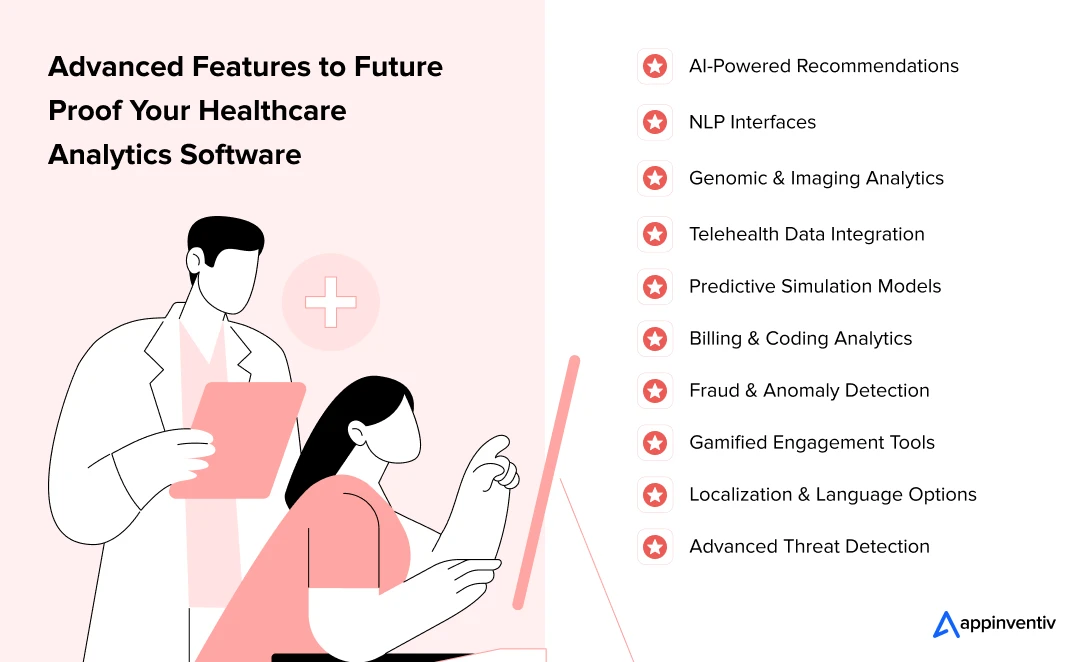
- AI-Powered Personalization and Recommendations
Use machine learning to deliver personalized insights and treatment recommendations based on patient history, demographics, and real-time data.
[Also Read: How is AI in Healthcare Transforming the Industry?]
- Natural Language Processing (NLP) Interfaces
NLP in healthcare software enables users to interact with data using conversational language queries, making analytics more accessible to non-technical healthcare professionals.
- Genomic and Imaging Data Analytics
Integrate genomic data and medical imaging analysis to support precision medicine initiatives and comprehensive patient profiling.
- Telehealth and Remote Monitoring Integration
Incorporate data from telemedicine visits and wearable health devices for continuous monitoring and real-time analytics.
- Advanced Predictive Modeling and Simulation
Deploy sophisticated simulations to forecast disease progression, resource utilization, and outbreak scenarios with high accuracy.
- Automated Billing and Coding Analytics
Analyze billing patterns and coding accuracy to reduce errors, optimize reimbursements, and improve financial performance.
- Fraud Detection and Anomaly Analytics
Identify unusual patterns or potential fraud in claims and transactions using AI-driven anomaly detection algorithms.
- Gamification and User Engagement Tools
Incorporate gamification elements such as rewards, badges, or challenges to motivate clinicians and staff to engage with analytics and improve performance.
- Multi-Language and Localization Support
Offer language options and regional customization to serve diverse geographic markets effectively.
- Advanced Security and Threat Detection
Integrate real-time security monitoring and threat detection systems to safeguard sensitive healthcare data continuously.
These advanced features position your white-label healthcare analytics software as a forward-looking, comprehensive platform — ready to meet evolving healthcare challenges and deliver exceptional value to clients.
How to Develop white-label Healthcare Analytics Software: Step-by-Step Process
Developing a successful white-label healthcare analytics software requires careful planning, collaboration, and adherence to healthcare standards. Here’s a clear roadmap to guide your development journey for solutions powered by advanced analytics in healthcare:
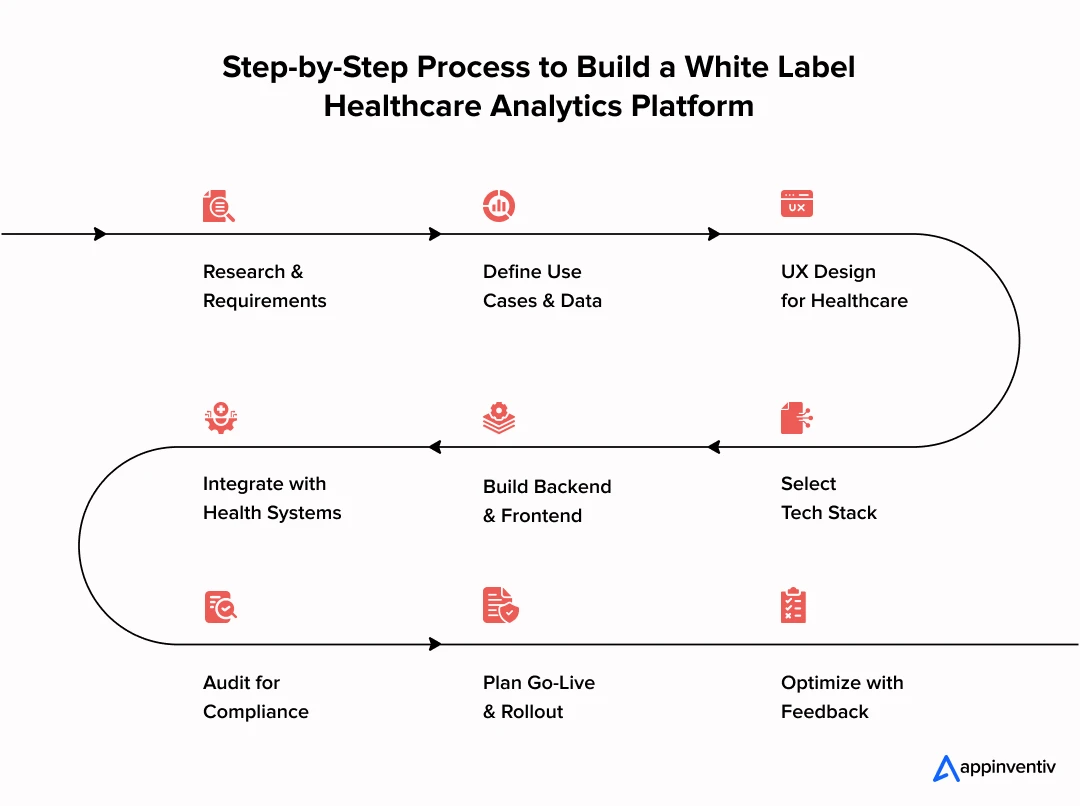 1. Market Research and Requirements Gathering
1. Market Research and Requirements Gathering
Start by understanding your target users, their pain points, and regulatory requirements. Identify the specific use cases for your healthcare analytics solutions to ensure the platform delivers real value.
2. Defining Use Cases and Data Sources
Map out critical analytics scenarios—such as clinical decision support, population health, or financial analytics—and determine the types and sources of data your software will need to handle.
3. UI/UX Design with Healthcare Users in Mind
Design intuitive, user-friendly interfaces tailored for different healthcare roles (clinicians, administrators, analysts) while ensuring compliance with accessibility standards.
4. Technology Stack Selection
Choose scalable, secure technologies including cloud platforms, AI/ML frameworks, and healthcare data standards (HL7, FHIR) to build a robust backend and responsive frontend.
5. Backend and Frontend Development
Develop core functionality such as data ingestion, processing pipelines, dashboards, reporting, and security features. Use modular development to facilitate customization and scaling.
6. Integration and Interoperability Testing
Thoroughly test integrations with EHRs, medical devices, and third-party systems to ensure seamless data flow and interoperability, addressing common healthcare analytics software challenges.
7. Compliance and Security Auditing
Conduct audits to verify that the software meets HIPAA, GDPR, FDA, and other relevant standards. Implement secure data encryption, audit trails, and access controls.
[Also Read: A Complete Guide to Healthcare Compliances]
8. Deployment and Go-Live Strategy
Plan for phased rollouts with continuous monitoring and support. Prepare documentation and training materials for clients to facilitate adoption.
9. Post-Launch Support and Iteration
Gather user feedback and usage data to continuously improve the platform. Plan regular updates to add features, improve performance, and maintain compliance.
Following these steps ensures you build an effective, scalable, and compliant advanced healthcare analytics software that delivers value to multiple healthcare organizations under your white-label solution.
How Do white-label Healthcare Analytics Software Solutions Make Money?
Monetization is a critical consideration when developing white-label healthcare analytics software. Choosing the right revenue model ensures sustainable growth and profitability while delivering value to your healthcare clients. Here are common monetization strategies in this space:
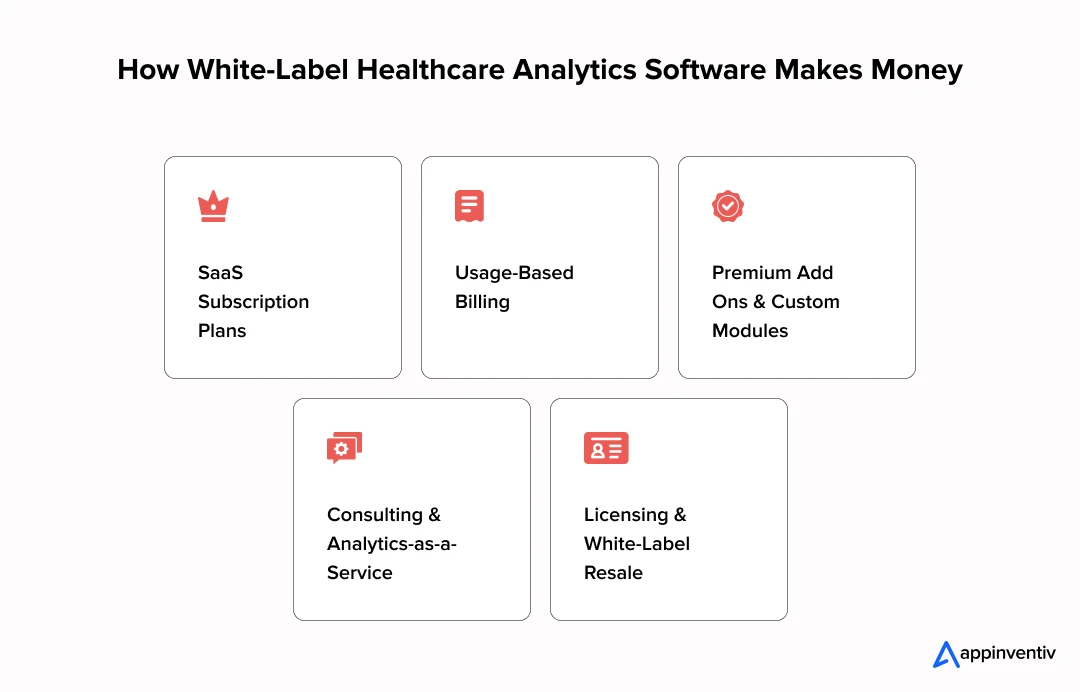
1. SaaS Subscription Plans
Charge healthcare organizations a recurring fee based on user seats, data volume, or feature tiers. This predictable revenue stream is ideal for scalable healthcare analytics solutions with ongoing updates and support.
2. Usage-Based Billing
Bill clients based on actual data processed, number of analytics queries, or API calls. This model aligns costs with usage, making it attractive for organizations with variable analytics needs.
3. Premium Add-Ons and Custom Modules
Offer advanced features such as AI-powered predictive analytics, genomic data integration, or custom reporting as paid add-ons to the core platform, allowing clients to tailor their solutions.
4. Consulting and Analytics-as-a-Service
Provide expert services like data strategy consulting, model development, or managed analytics support. This builds deeper client relationships and additional revenue beyond software licenses.
5. Licensing and White-Label Resale
Allow partners to license your platform and resell it under their own brand, expanding your market reach while generating royalties or licensing fees.
By aligning your monetization strategy with client needs and market trends, your advanced healthcare analytics software can generate sustained revenue and foster long-term partnerships.
Why Appinventiv Is the Right Partner to Build Your White-label Healthcare Analytics Software
We hope this blog has helped you understand in detail the cost to build a white-label healthcare analytics software and the factors that impact it. If you’re ready to invest in the best white-label healthcare analytics software, partnering with a skilled development team that understands healthcare data nuances is critical. At Appinventiv, we bring deep expertise and a proven track record in healthcare technology that sets us apart:
Healthcare Domain Expertise: We understand the unique challenges of healthcare data, compliance, and interoperability, enabling us to build solutions that meet strict regulatory standards like HIPAA, GDPR, and FDA requirements.
Advanced Analytics Capabilities: As a custom healthcare software development company, our team specializes in building advanced healthcare analytics software with AI, machine learning, predictive modeling, and real-time data processing — delivering actionable insights that drive better clinical and operational decisions.
Custom White-Label Solutions: We tailor every platform to your brand and client needs, ensuring seamless multi-tenant support and full customization across UI, workflows, and integrations.
Robust Security & Compliance: We implement end-to-end encryption, role-based access controls, audit trails, and continuous security monitoring to protect sensitive healthcare information.
Agile & Collaborative Development: Our agile processes ensure transparency, flexibility, and faster time-to-market while maintaining the highest quality standards.
Post-Launch Support & Growth: We don’t just deliver software — we partner for ongoing updates, scalability, and optimization to keep your healthcare analytics solutions competitive and future-ready.
With Appinventiv as your development partner, you gain a trusted ally committed to transforming your vision into a powerful, compliant, and scalable white-label healthcare analytics software platform that drives real value for your business and clients. Whether you need to hire developers for whitelabel healthcare analytics software development or consult on strategy, informed decisions today can lead to transformative healthcare solutions tomorrow.
FAQs
Q: How long does it take to build a white-label healthcare analytics software?
A: Development timelines vary widely based on scope and complexity but usually range between 6 to 12 months. This includes phases like research, design, development, testing, compliance auditing, and deployment.
Q: What are the biggest challenges in developing healthcare analytics software?
A: Developing effective healthcare analytics software comes with several key challenges, including:
Regulatory Compliance: Ensuring the software meets strict data privacy laws like HIPAA, GDPR, and FDA guidelines requires ongoing audits and secure design practices.
Data Integration: Handling diverse and often incompatible data sources such as EHRs, medical devices, and lab systems demands robust and flexible integration solutions.
Data Quality and Consistency: Maintaining clean, accurate, and standardized data is critical for reliable analytics outcomes.
Scalability and Security: Designing multi-tenant architectures that securely separate data for multiple clients while scaling efficiently is complex.
User Adoption: Creating intuitive interfaces that meet the needs of clinicians, administrators, and analysts is essential to ensure widespread platform use.
Q: How much does it cost to develop a white-label healthcare analytics software?
A: The cost to build a white-label healthcare analytics software typically ranges from $40,000 to $250,000 or more, depending on the complexity of features, customization, integrations, compliance requirements, and scalability needs. Basic solutions fall on the lower end, while enterprise-grade platforms with advanced AI and multi-tenant capabilities are on the higher end.
Q: Can a white-label healthcare analytics software integrate with existing EHR and medical systems?
A: Yes, integration with existing healthcare IT systems is a cornerstone of effective white-label analytics solutions. Key integration features include:
Custom Connectors and APIs: Developed to link with various EHR, EMR, LIS, and RIS systems regardless of vendor or format.
Standards Compliance: Support for healthcare data standards like HL7, FHIR, and DICOM to facilitate seamless data exchange.
Real-Time Data Sync: Enabling up-to-date analytics by continuously syncing with clinical and operational data sources.
Interoperability Testing: Rigorous testing ensures stable, secure, and accurate data flows between systems.
Flexible Architecture: Designed to accommodate future integration needs as healthcare IT ecosystems evolve.
Q: What are some benefits of white-label healthcare analytics software for businesses?
A: White-label healthcare analytics software offers numerous advantages for businesses looking to expand their offerings and drive growth, including:
- Faster Time-to-Market: Launch a customizable, ready-built solution quickly without developing from scratch.
- Cost Efficiency: Save on development costs by leveraging an existing platform that can be tailored to your brand.
- Scalability: Easily serve multiple healthcare clients with a secure, multi-tenant architecture.
- Brand Control: Maintain full branding and customization, strengthening your market presence.
- Enhanced Client Retention: Provide continuous value through advanced analytics that improve healthcare outcomes.
- Regulatory Compliance: Benefit from platforms designed to meet healthcare data privacy and security standards.
- Revenue Diversification: Open new income streams through software licensing, subscriptions, or managed services.
For businesses, the future of healthcare analytics software is promising, with AI, IoT, and real-time data ushering in more proactive, personalized care. As technology evolves, the benefits of white-label healthcare analytics software will only grow, enabling providers and labs to deliver better outcomes under their own brands.
Product Development & Engineering
IT Managed & Outsourcing
Consulting Services
Data Services
Didn't find what you're looking for? Let us know your needs, and we'll tailor a solution just for you.




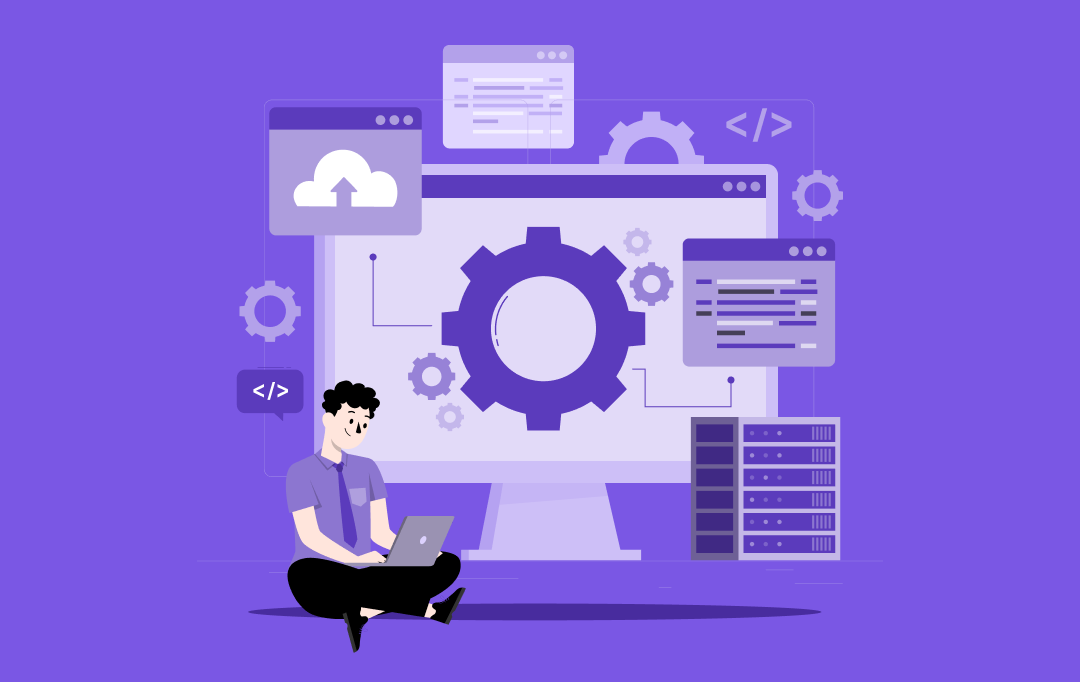




















 1. Prioritize Core Features with an MVP Approach
1. Prioritize Core Features with an MVP Approach

 1. Market Research and Requirements Gathering
1. Market Research and Requirements Gathering


